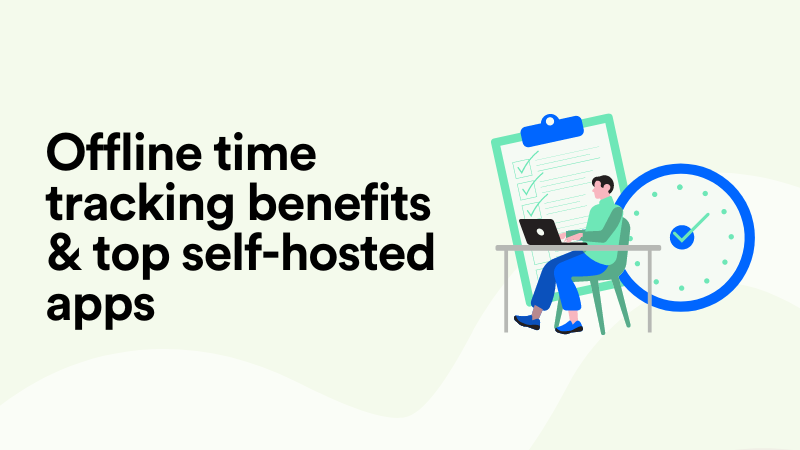Top 10 Everhour Alternatives for Accurate Time Tracking (Compared)

So, you are thinking about exploring alternatives to Everhour? Maybe timesheets feel like more work than they should. Or perhaps you’re just curious how other tools compare and what features you might be missing.
Don’t worry; we’ve got you.
We’ve rounded up the top 10 Everhour alternatives that could tick all your boxes (and count all your billable hours). We listed all the features, dug into the real user ratings, listed pricing, and highlighted what each tool does best.
And because nobody has time to scroll through walls of text, we also created a handy comparison table so you can spot the best fit for you and your team in 5 seconds.
We did the homework, so you can just copy the answers. 🙂 Just keep on reading!
Key Takeaways:
- Memtime – Automatic time tracker that runs silently in the background, captures all small tasks, and helps optimize workflow.
- Clockify – Flexible time tracking tool with manual and automatic modes, integrations, and invoicing features.
- Toggl Track – Clean time tracking app with manual and background tracking, and customizable reporting.
- Harvest – Time tracking and invoicing platform with budget management and reporting by project and client.
- Hubstaff – Time tracking app with employee monitoring features, built for remote teams who want oversight.
- Timely – AI-powered time tracking tool with automatic background logging, cloud sync, and visual timelines.
- RescueTime – Automatic background activity tracker that categorizes time as productive or unproductive to improve work habits.
- Time Doctor – Time tracking platform with automatic logging, app and website monitoring, and optional screenshots.
- TimeCamp – Time tracking tool with automatic logging, GPS location tracking, and reporting.
- TMetric – Time tracking tool offering manual and semi-automatic tracking, invoicing, and project management features.
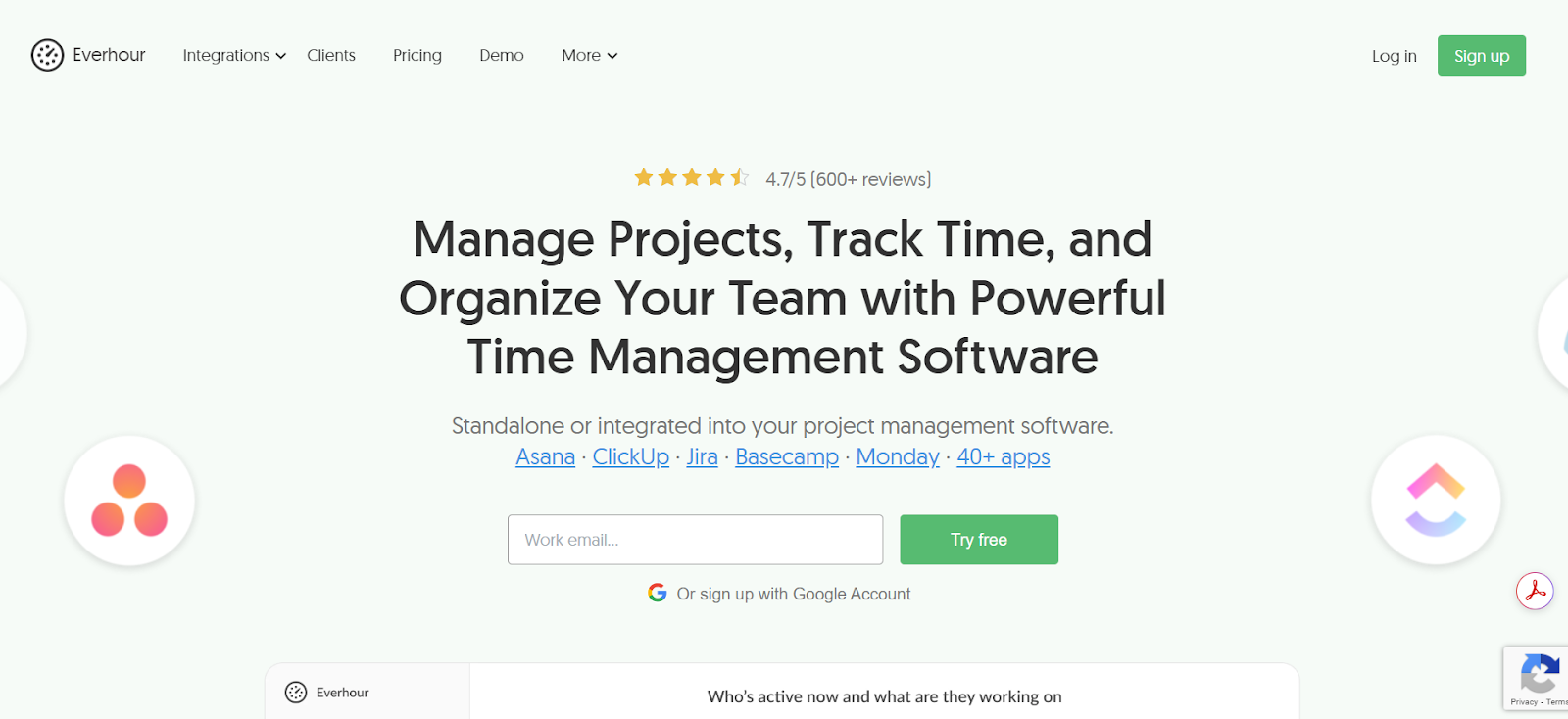
But first, just a quick recap—what is Everhour?
Everhour is a SaaS time tracking and project management tool.
It’s designed as a tool for teams to help them log hours, manage projects and tasks, monitor budgets, and generate reports and invoices. Today, it’s mostly used by SMBs, agencies, remote teams, and freelancers.
The idea for the app originated inside a small IT outsourcing company, Weavora, in 2010. The team was using tools that didn’t quite fit their needs for time tracking, comparing estimates and actuals, and invoicing. They tried various tools, found them lacking, and decided to build their own.
Five years later, Everhour was officially launched. And fifteen years later, Everhour has over 8,000 customers globally.
Everhour features worth noting
Here are some of the most prominent Everhour features, related to time tracking, project planning, billing, reporting, and team management:
- Everhour is available on desktop (Windows, macOS), mobile (Android, iOS), and web (browser extension).
- You can start/stop a timer to track time as you work, or enter hours manually afterward. There are reminders for when timers run long, as well as settings that auto-stop timers at specific times.
- Everhour supports clocking in and out.
- For employees who don’t log individual task hours, the Timecards feature allows them to view the total hours worked each day or week.
- You can organize work by project, tasks, and subtasks.
- You can set estimated hours for tasks or projects, as well as budgets (and choose whether you bill by project hourly, person hourly, or fixed fee).
- You can generate reports like timesheets, project milestones, sprint reviews, and time by tag. You can also view this information at the project or member level, including hours spent, billable vs. non-billable hours, cost, profit vs. cost, and budget spent and remaining.
- Everhour offers different roles and permissions that limit access control. Admins can require timesheets to be submitted and approved.
- The app can track leave, absence, vacations, and holidays, and integrate them so that team capacity planning or availability considers them as needed.
- The app tracks work-related expenses (like travel and materials). You can attach receipts and categorize expenses.
- You can create invoices directly from time and expenses, and customize them.
- You can set costs (employee costs) and what you charge, track profit, and revenue.
- For teams wanting oversight, Everhour can take screenshots of activity at intervals (this feature is available only on desktop).

What Everhour could be lacking
No tool is perfect. Everhour gets plenty of love for its user-friendly interface and numerous integrations, but some users do point out gaps. Those gaps are not deal-breakers per se; they’re more information on how the app actually behaves:
- Many users find the tool to be somewhat expensive, especially for smaller teams, solo contractors, or startups.
- For users who don’t need everything, Everhour options (reports, integrations, budget tracking, etc.) can be a bit much at first. Smaller teams often feel like they only use a fraction of what’s offered, rather than the entire system structure. Plus, users report that particular features, such as comments, reassigning tasks, or using subtasks, require more clicks and more setup than they’d like.
- A few users mentioned issues like timers not stopping. Also, needing a reliable internet connection, which can be limiting when someone is offline or travelling. Some features are missing or less reliable when network connectivity is not as good.
At the end of the day, these aren’t fatal flaws; they are just reminders that Everhour can’t be the right fit for everyone.
And that’s exactly why we’ve pulled together the top 10 Everhour alternatives list, to help you find a tool that matches your workflow and budget.
Top 10 Everhour alternatives
Memtime
Want a tool that can track your time, but you won’t even remember it’s there?
We got you.
Meet Memtime, our automatic time tracker built to capture everything you do digitally, including apps, meetings, documents, and browser tabs, all to help you reconstruct your day with precision. No manual timers, no disruption.
Here are Memtime’s major features that take time tracking to the next level:
- You get automatic offline tracking. Memtime runs in the background (on Windows, macOS, and Linux) and automatically records foreground activity: programs, documents, browser tabs, meetings, and files. All the raw activity data is stored locally on your device, not uploaded to the cloud (not even the team at Memtime can access your data).
- You get a Memory Aid timeline. You get a visual timeline of your workday (Memory Aid) in intervals of 1-60 minutes. You can zoom in and out (think 6-minute increments) to see finer detail.
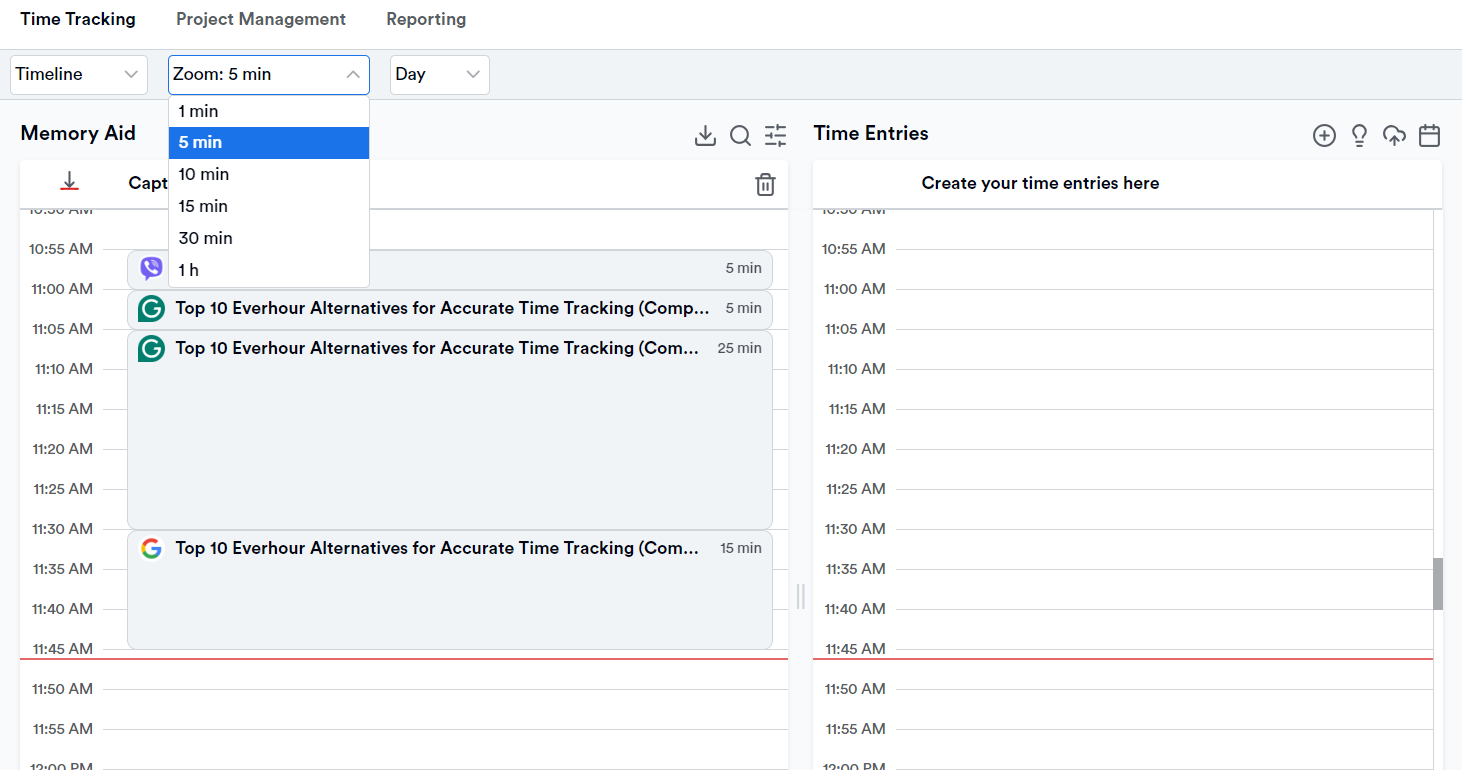
- You can create time entries (or Memtime can do it for you). From the timeline, you can convert captured activities into time entries manually. You can also add “suggestion rules” to automate the process. For example, when a specific URL, document path, or email subject matches a rule, Memtime will suggest a time entry.
- You can integrate projects and tasks. You can import projects and tasks from project management tools, then export the time entries back to them (thanks to our 2-way sync and 100+ integrations). Memtime also supports creating local custom projects if you don’t use external project software.
- You can connect it to your calendar. Memtime integrates with calendar apps, allowing you to pull in meeting and event data, and later compare planned vs. actual time. 📅
- You don’t have to worry about privacy. All your activity data stays offline; only you can see the detailed timeline. You decide what to export or share (as time entry or project data) and delete data at any time.
Still unsure what Memtime does better than Everhour?
Everhour is strong in a lot of areas (task tracking, integrations, and reporting), BUT Memtime does one thing exceptionally well: time tracking. Plus, it allows you to connect the results directly to your projects and tasks.
Here’s where Memtime brings its A-game:
- Granular visibility into what you worked on. I’m talking file names, browser tab titles, document names, not just “App x was open for y minutes”.
- There’s minimal friction. Tracking happens automatically; you don’t need to start and stop timers constantly and then forget to turn them off; it’s a major convenience.
- Privacy is a top concern. Your raw activity data stays local, and you control exports, so there’s no data leaks or misuse, especially in remote and distributed teams.
Memtime doesn’t try to be eVeRyThInG; it has just one focus—time tracking—and it does it better than anyone else. ✨ Plus, with 100+ integrations, you can still connect it to your favorite project or billing apps without losing focus.
Try Memtime free for 2 weeks and see for yourself what I’m talking about; it’s on us. No credit card required.
Just click below and see how effortless and accurate time tracking can be.
Clockify
Clockify is one of the most popular time tracking and workforce management tools. It’s especially popular among freelancers, remote teams, and businesses that want manual time tracking and a decent number of integrations.
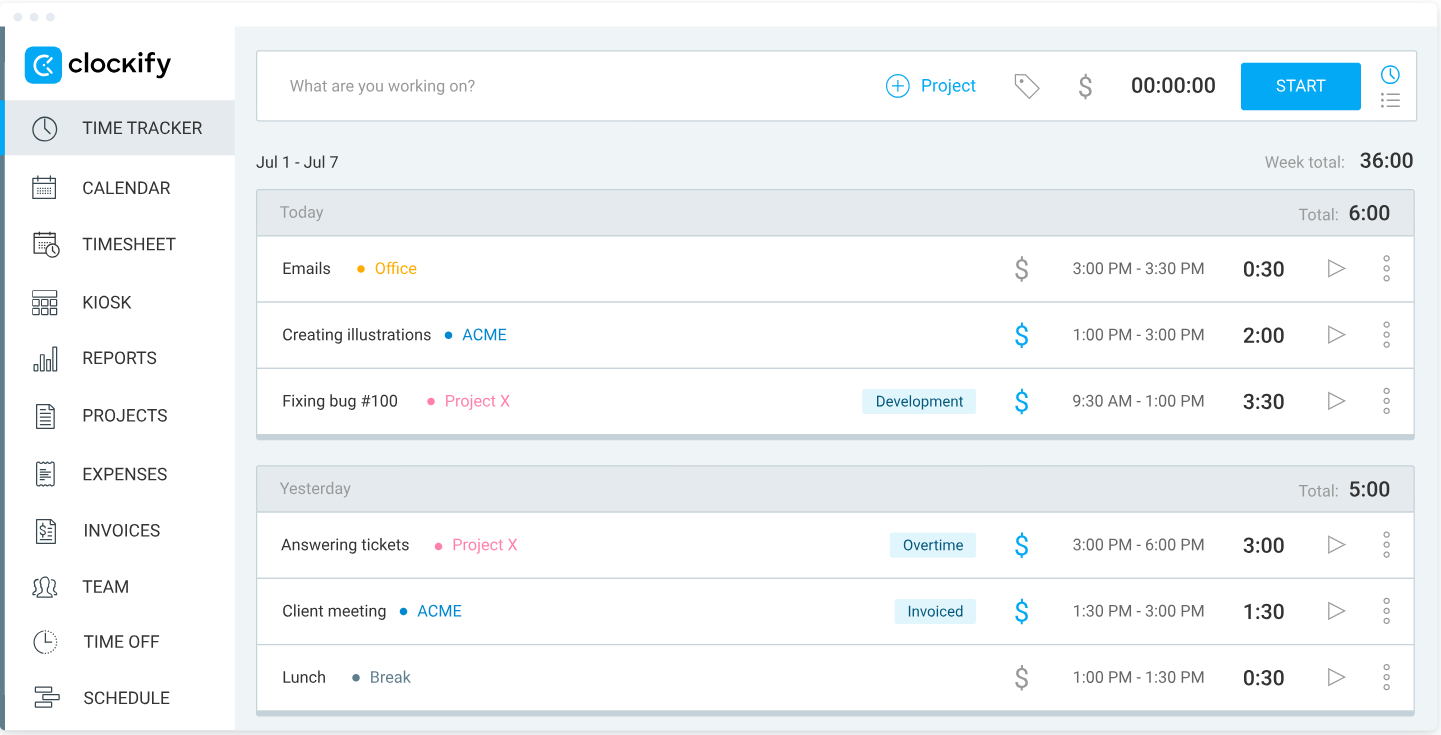
Here are some of Clockify’s key features:
- You can use a stopwatch timer, add manual time entry, or drag-and-drop editing to log hours.
- There’s also an Auto Tracker, which runs locally to capture app and website activity in the background, so you can later convert it into time entries.
- The app prompts you to remove, keep, or split idle periods.
- There’s a Pomodoro timer to help with focus and track work in short bursts.
- You get daily or weekly timelines, and you can add, edit, or duplicate entries.
- The app syncs with Google Calendar and Outlook.
- You can generate reports filtered by client, project, user, date, and location.
- You can assign time entries to clients, projects, or tasks, and set billable and non-billable rates.
- The app also includes clock-in kiosks, GPS location tracking, screenshot capture, and leave tracking.
- You can create invoices from tracked time and expenses, customize rates and client details, and export PDFs for direct billing.
- You can plan shifts, track budgets, and receive alerts to avoid overspending.
- 90+ integrations are available (the 2-way sync works only with QuickBooks).
- The app is cloud-based.
Clockify is a flexible tool that comes with a generous free plan (which supports unlimited users). It’s a good option for growing teams on a budget, as it provides manual time tracking along with reporting and invoicing.
Toggl Track
Toggl Track is another well-known time tracking app. It’s famous for its clean interface, flexible manual tracking, and a good number of integrations; it’s pretty similar to Clockify but a bit more polished.
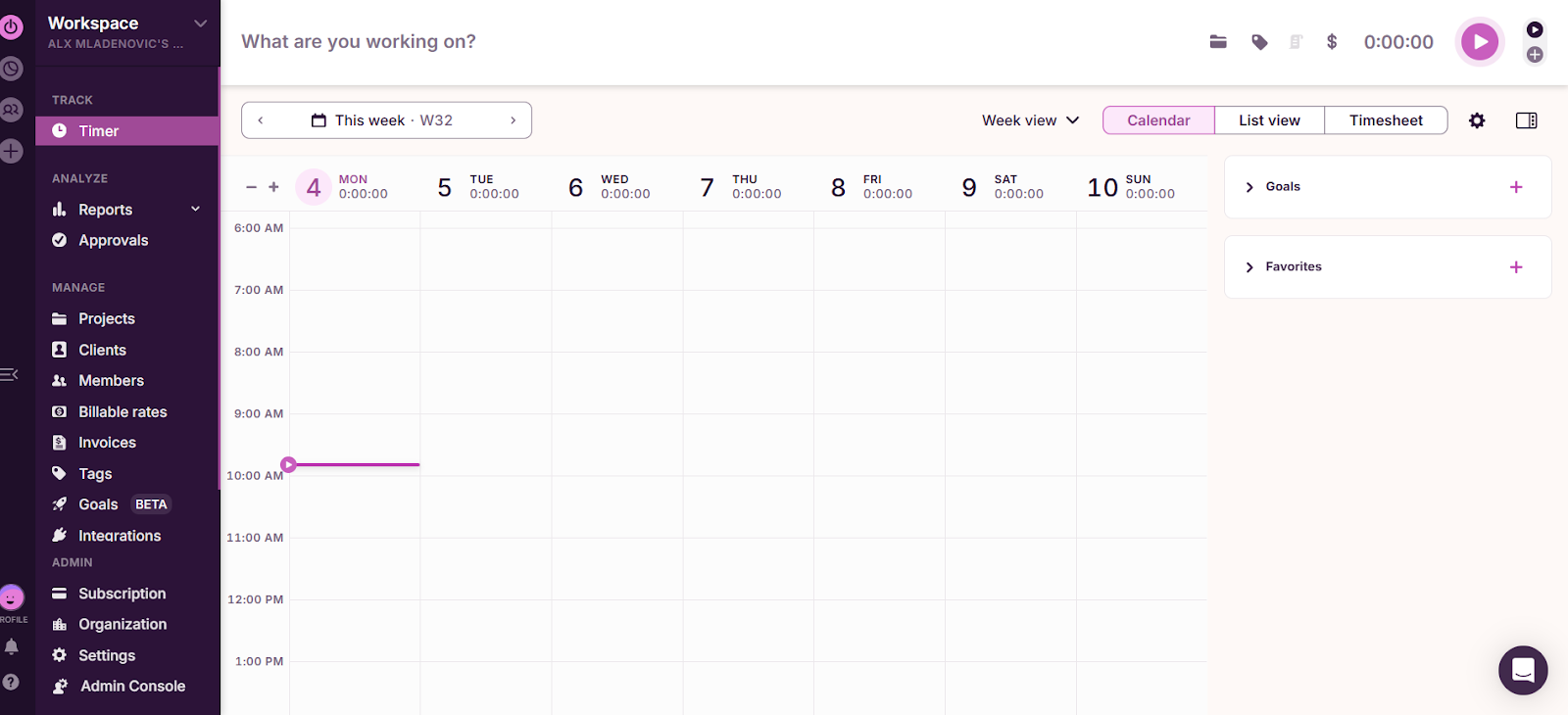
Here are some of the tool’s key features:
- You get manual and background tracking; start/stop timers for manual tracking or use the Timeline feature to passively monitor activity on your computer, tracking any app or website you use for more than 10 seconds.
- There’s idle time detection, which alerts you when you’ve been away and lets you discard or keep idle time.
- There’s a Pomodoro timer, which helps you work in focused bursts.
- The app displays your tracked activity in 15-minute increments.
- You can break down tracked time by project, client, team, or tag, separate billable vs. non-billable hours, and export reports.
- You can organize work by client or project, set an estimated time, and track progress.
- 100+ integrations are available (only 4 of them provide a 2-way sync), including Google Calendar, Jira, Asana, Trello, Slack, GitHub, and more.
- All data is stored online (in the cloud).
Toggl Track can be a good choice for teams and individuals who want a simple, clean interface with mostly manual time tracking (the Timeline background tracking can come in handy if you want a passive option alongside manual time entry). Its reporting features can work well for those who need to analyze team productivity and billable hours.
Harvest
Harvest is a time tracking and invoicing tool primarily marketed to freelancers, agencies, and client-focused businesses that want to track time, manage budgets, and bill clients.
The app is all about understanding that time equals money and that you should keep tight control over both.
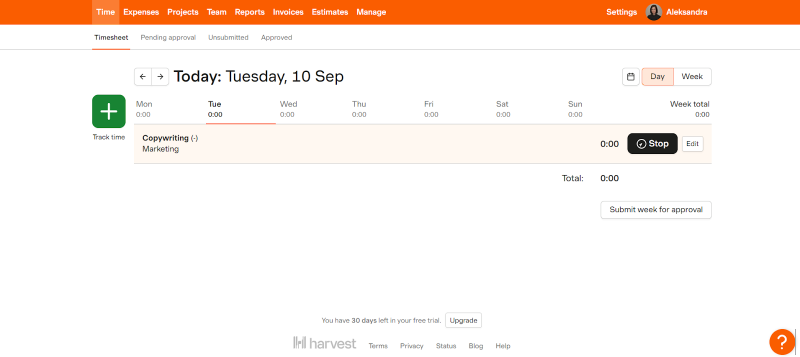
Harvest combines time tracking, expense logging, invoicing, and reporting in one interface.
Here are some of the app’s most prominent features:
- You can use a Start/Stop timer or log hours manually across tasks and projects.
- You can upload receipts, tag expenses as billable or non-billable, and keep budgets updated.
- You can convert tracked time and expenses directly into invoices without leaving the app.
- You can track budgets, retainers, and project costs per client and view detailed reports by team member, task, project, or client.
- You get time tracking reminders, as daily or weekly prompts, to help you log your time.
- There are some team monitoring features, like seeing who’s working on what, tracking billable hours, and managing capacity.
- You can approve timesheets and expenses before they are billed.
- The app integrates with cloud storage, allowing you to access time entries, reports, and invoices from anywhere through online syncing.
Harvest is a strong option for teams or freelancers who want manual time tracking, expense management, and invoicing without much of a setup. It keeps billing straightforward while giving managers visibility into budgets, workloads, and team productivity.
Hubstaff
Hubstaff is a time tracking and productivity management app built primarily for remote and hybrid teams that want visibility into work hours, productivity, budgets, and field operations. It blends time tracking with team monitoring features, invoicing, budget tracking, and GPS tracking, so it’s more than just a timer app.
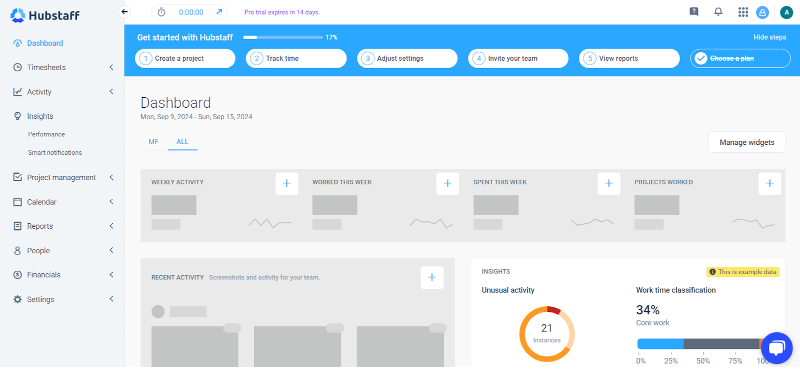
I would say it’s also a manager-friendly app, meaning managers can see more than just time logs; they can establish oversight and control over distributed teams.
Here are some of the tool’s key features:
- You can track time with a Start/Stop timer or let Hubstaff start and stop automatically based on schedules or shifts.
- The app detects inactivity and auto-prompts to keep or discard idle time; it tracks activity levels based on keyboard and mouse usage.
- You get optional screenshot monitoring, meaning the app can capture screenshots at set intervals.
- You can track hours and locations for field teams with mobile apps.
- You can create invoices and manage budgets by project or client.
- Hubstaff connects with over 30 productivity, project management, and accounting tools.
- There’s automated payroll, so you can pay your team automatically based on tracked hours.
- With Hubstaff’s reporting, you get insights into time usage, productivity, and project costs.
Hubstaff is a good tool for businesses that want oversight of remote teams, productivity monitoring, and budget control in a single platform. It’s more of a workforce management app that blends time tracking with team accountability features.
Timely
Timely is an AI-powered, automatic time tracking app. There are no Start/Stop timers; Timely automatically captures your activity across apps, documents, browser tabs, and meetings, and then organizes it into a timeline.
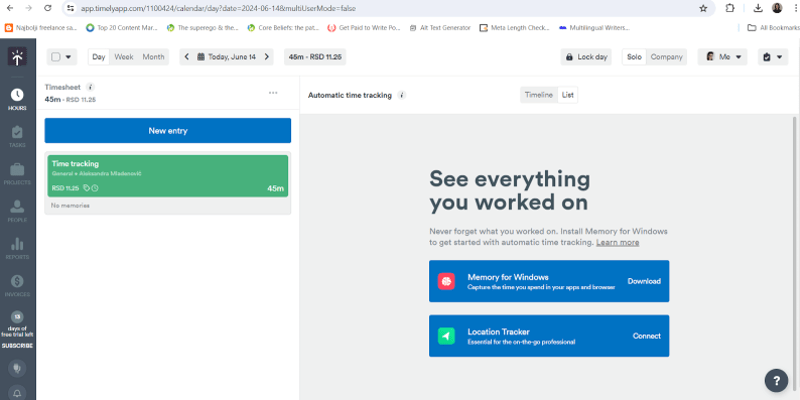
It’s pretty similar to Memtime, but it differs in one way. Timely is built around its Memory app, which runs quietly in the background and syncs your data to the cloud. Unlike some tools, it doesn’t offer a full desktop interface for managing entries; you’ll need to log into the web app to view, edit, and manage your tracked time.
Here are some of Timely’s key features:
- The tool automatically captures your activity as it tracks apps, files, websites, and meetings in real-time without requiring manual input.
- AI handles the organization of activities, as it groups them into projects, clients, or tasks.
- Your tracked activities remain visible only to you, unless you choose to share them with a team (although they cloud sync).
- You get visual dashboards for project tracking, capacity, and performance insights.
- You can compare billable vs. non-billable hours.
- There’s a cloud-based storage, meaning all data syncs to the cloud so you can access it across devices.
Timely is a decent option for professionals and teams who want automatic tracking with added AI.
RescueTime
RescueTime is an automatic time tracker built to help individuals and teams understand where their time goes and reclaim focus during the workday. It runs in the background across devices, categorizing your activity as either “productive” or “unproductive” and showing you insights through reports and trends.

The tool also includes Focus Sessions, which block distractions when you need deep work time. If you’re a Spotify Premium user, you can even sync a playlist to set the right mood for concentration.
Here are some of the tool’s key features:
- The app runs in the background across Windows, macOS, iOS, Android, and browser extensions.
- RescueTime tracks activity automatically without Start/Stop buttons or manual entry.
- You can label apps and websites as productive or unproductive.
- Thanks to Focus Sessions, you can block distractions on demand, with optional Spotify playlist integration.
- All your data is synced across multiple devices.
- You can set targets for focus time or screen time and get nudges when you’re off track.
- You get visual reports and productivity trends.
- The tool connects with Google Calendar, Asana, Slack, and more.
RescueTime is best for individuals who want automatic tracking plus tools to improve focus. The app is not that business-oriented; it’s more of a personal productivity and habit-building tool. There are no options for team oversight or billing.
Time Doctor
Time Doctor is a time tracking and employee productivity tool built for remote and hybrid teams. It combines traditional time tracking with employee monitoring features like screenshots, website tracking, and activity alerts. The app’s goal is to give managers visibility into how teams spend their time and help reduce unproductive hours.
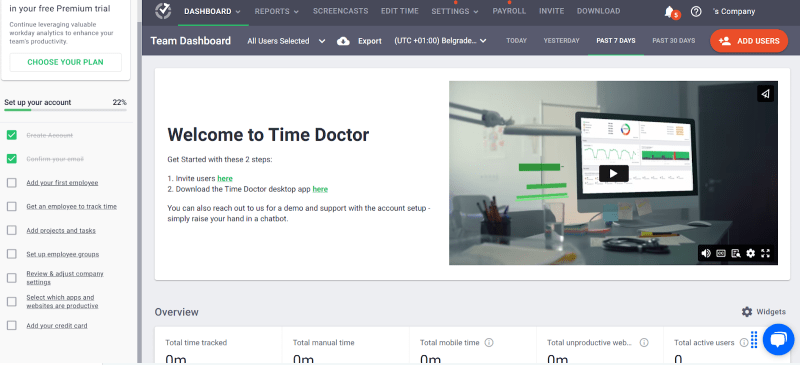
Here are some of Time Doctor’s most prominent features:
- You get manual and automatic time tracking. You can track time with Start/Stop timers or rely on background tracking.
- Alerts pop up when no keyboard/mouse activity is detected.
- The app monitors the websites you visit and the apps you use, categorizing activity as productive, unproductive, or neutral.
- Time Doctor prompts users when they visit non-work-related websites.
- You can organize work (projects and tasks) within the app or through integrations.
- You can create invoices with customizable hourly rates per project or user.
- You get insights into time usage, productivity trends, and team performance.
- Time Doctor allows optional webcam shots, screen recordings, and video captures.
- All tracked data is stored in the cloud.
Time Doctor is geared toward companies that want time tracking AND employee monitoring; the tool is all about oversight, accountabilityoversight accountability, and workforce management. If that’s what you’re into, give this tool a go.
TimeCamp
TimeCamp is a well-rounded platform that combines time tracking with invoicing, budgeting, and productivity analytics. It’s designed to help freelancers and teams log their time and connect it directly to project profitability and client billing.

When it comes to time tracking, you have 2 options.
You can log time manually using Start/Stop timers or directly enter into timesheets. You can also rely on automatic tracking that uses keywords and activity monitoring to record tasks in the background.
Here are some of the tool’s key features:
- You can use timers, direct timesheet entries, or keyword-based activity monitoring (a more automated approach).
- You get daily, weekly, and graphical timesheet views for quick edits and approvals.
- The app performs keyword-based tracking; it detects window titles, URLs, or apps tied to specific projects or tasks.
- TimeCamp categorizes websites and apps as productive or distracting.
- You can create invoices based on tracked hours, with customizable billing rates.
- You can monitor check-ins, leaves, and overall work hours.
- You can analyze time usage, budgets, profitability, and team performance.
- The tool prompts you to edit incomplete time entries and detects idle time.
- All data is synced and stored in the cloud.
TimeCamp can work well for freelancers, agencies, and teams who want flexible time tracking, billing, and productivity insights. Its combination of invoicing, budgeting, and reporting tools can work well for service-based businesses.
TMetric
TMetric is a time tracking tool designed for freelancers, small businesses, and teams that want tracking combined with billing and team management features. It offers manual and (semi-)automatic time tracking options, reporting, invoicing, and project budgeting tools to manage client work.
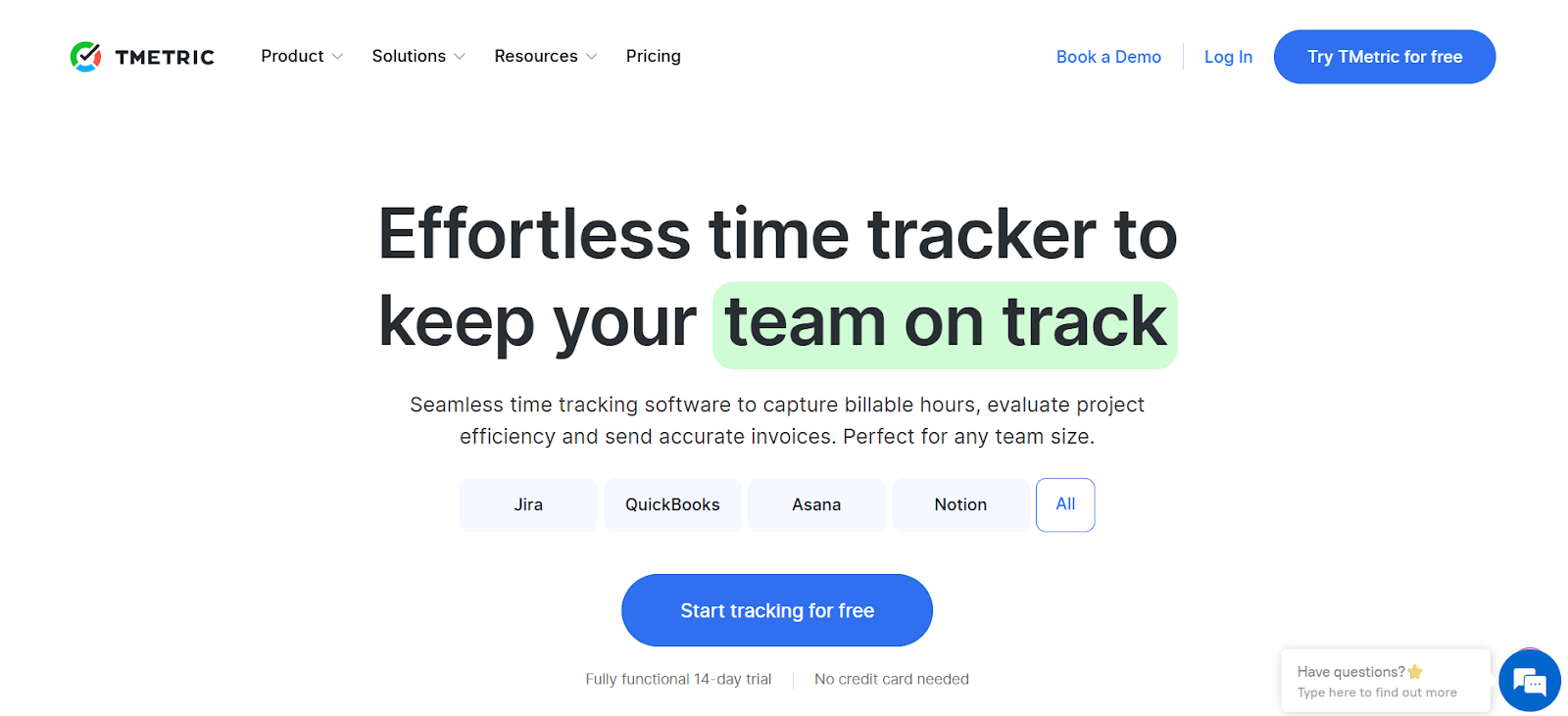
TMetric markets itself as an easy-to-use tool that supports team oversight, attendance tracking, and task management.
Here are some of the app’s key features:
- You can use Start/Stop timers and do timeline editing.
- TMetric supports automatic task time tracking via its desktop app. The automation is that it can detect zero activity (idle time) and notify the user or pause the timer automatically. It also allows offline automatic time tracking and later syncing when online.
- You can compare billable vs. non-billable hours, set customizable rates, and do client invoicing.
- You can do budgeting, cost tracking, and deadline management for projects.
- TMetric also offers attendance tracking, time-off requests, and workload monitoring.
- The app connects to over 50 other tools, including project management, communication, and accounting tools.
- The app is available on web, desktop, and mobile with data synced to the cloud.
TMetric is best for freelancers and small to medium-sized teams that need a manual time tracker with billing and simple workforce management features.
Wrapping up
So, so, so. No matter if you’re fed up with timesheets that feel more like timeshambles or just on a hunt for an app that doesn’t require a PhD in UI design, there’s plenty here to explore.
You’ve gone through all 10 Everhour alternatives. Do with all that information what you will.
BUT if you want a tool that actually tracks without being nosy, Memtime should be your new best friend. It works quietly in the background, keeps your data to yourself, and makes sure you don’t accidentally bill your client for your lunch breaks… unless you want to (no judgment).
After all, time is money, and Memtime makes sure you actually get paid for both. 😉
What are the best alternatives to Everhour for time tracking?
The best Everhour alternatives depend on your needs, including features like automatic tracking, invoicing, reporting, and integrations. Popular options include Clockify, Toggl Track, Harvest, Hubstaff, Timely, and Memtime. Memtime stands out as an alternative by offering fully automatic tracking, offline storage, privacy controls, and a Memory Aid timeline to reconstruct your day.
How do Everhour alternatives compare in features and pricing?
Everhour alternatives vary; some focus on simple time tracking, others on invoicing or team management. Tools like Clockify and Toggl Track offer free tiers, while Hubstaff and Timely focus on advanced features for teams. Memtime offers a free trial with automatic tracking and premium privacy features, making it easy for you to experience how passive time capture fits your workflow before committing to a paid plan.
Can I easily switch from Everhour to another time tracking tool?
Yes, most time tracking tools allow importing data from Everhour or offer flexible setup for new projects. Switching depends on the alternative you choose and the features you need.
What should I consider when choosing an Everhour alternative?
When choosing an alternative, consider whether you need manual or automatic tracking, integrations with your existing tools, reporting capabilities, privacy features, and cost. If you want effortless, privacy-first tracking without manual timers, Memtime is a strong choice.
Are there free Everhour alternatives available?
Yes, some Everhour alternatives offer free plans with core time tracking features. Clockify, Toggl Track, and TimeCamp all come with free plans. These free options are useful for freelancers and small teams who want time tracking without committing to a paid plan.
Which Everhour alternatives are best for remote teams?
For remote teams, look for tools that offer automatic tracking, collaboration features, integrations, and privacy options. Hubstaff, Timely, and Memtime are strong choices. Memtime offers automatic tracking with offline storage, privacy controls, and a Memory Aid timeline to help remote teams keep accurate logs of work.
Aleksanda Doknic
Aleksandra Doknic is a copywriter and content writer with six years of experience in B2B SaaS and e-commerce marketing. She's a startup enthusiast specializing in topics ranging from technology and gaming to business and finance. Outside of work, Aleksandra can be found walking barefoot in nature, baking muffins, or jotting down poems.

